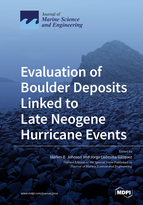Evaluation of Boulder Deposits Linked to Late Neogene Hurricane Events
A special issue of Journal of Marine Science and Engineering (ISSN 2077-1312). This special issue belongs to the section "Geological Oceanography".
Deadline for manuscript submissions: closed (1 May 2021) | Viewed by 20300
Special Issue Editors
Interests: paleoecology; rocky-shore ecosystems; island dynamics; phanerozoic sea-level changes; storm deposits; carbonate dune systems; paleogeography of Baja California (Mexico) and the macaronesian islands of the NE atlantic
Special Issues, Collections and Topics in MDPI journals
Interests: coastal sedimentology; rocky-shore deposits; tectonics; island geology; Phanerozoic sea-level changes; coastal dune systems; paleogeography of Baja California (Mexico) and the Macaronesian islands of the NE Atlantic
Special Issue Information
Dear Colleagues,
The study of hurricane deposits in the aftermath of landfall (Ball et al. on Florida’s Hurricane Donna in 1960) has been innovative in approach. Subsequent development of the mathematics behind megaclast hydrodynamics provides insight on the strength of pre-historic storms. Boulder deposits with or without organics (i.e., large coral heads) from the last few million years are newly open to quantification. Tidal forces, prevailing currents, and tsunamis must be taken into account, but regional geography aids in their potential elimination as contributing factors. The Holocene, Pleistocene, and Pliocene Warm Period are of particular interest. Storm deposits from these intervals provide a forecast for the near future under conditions of accelerated global warming at a rate previously unmatched. Contributions on coastal boulder deposits are solicited, but also on outwash deposits due to excessive rainfall. Survey papers on risk zones for hurricane landfall as well as literature reviews on the extent of published material from the Late Neogene are welcome.
Prof. emer. Markes E. Johnson
Prof. emer. Jorge Ledesma-Vázquez
Guest Editors
Manuscript Submission Information
Manuscripts should be submitted online at www.mdpi.com by registering and logging in to this website. Once you are registered, click here to go to the submission form. Manuscripts can be submitted until the deadline. All submissions that pass pre-check are peer-reviewed. Accepted papers will be published continuously in the journal (as soon as accepted) and will be listed together on the special issue website. Research articles, review articles as well as short communications are invited. For planned papers, a title and short abstract (about 100 words) can be sent to the Editorial Office for announcement on this website.
Submitted manuscripts should not have been published previously, nor be under consideration for publication elsewhere (except conference proceedings papers). All manuscripts are thoroughly refereed through a single-blind peer-review process. A guide for authors and other relevant information for submission of manuscripts is available on the Instructions for Authors page. Journal of Marine Science and Engineering is an international peer-reviewed open access monthly journal published by MDPI.
Please visit the Instructions for Authors page before submitting a manuscript. The Article Processing Charge (APC) for publication in this open access journal is 2600 CHF (Swiss Francs). Submitted papers should be well formatted and use good English. Authors may use MDPI's English editing service prior to publication or during author revisions.
Keywords
- Coastal boulder deposits (CBDs)
- Coastal outwash deposits (CODs)
- Hurricane dynamics
- Wave surge modelling
- Coastal geomorphology
- Prediction of high-risk zones for hurricane landfall
- Literature review on the geologic record







